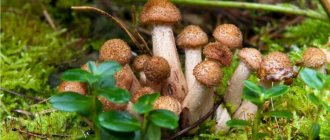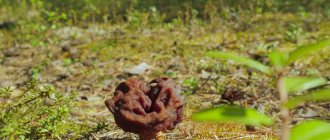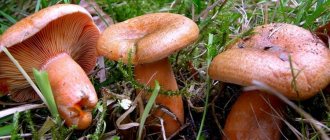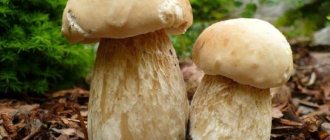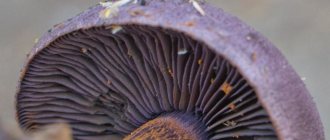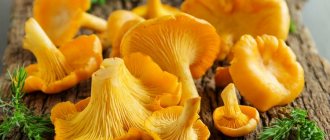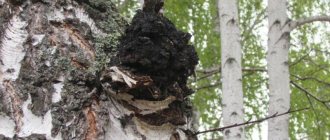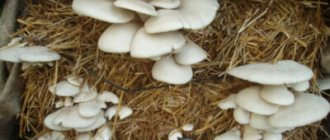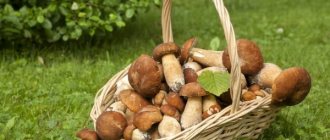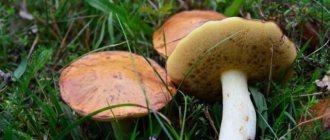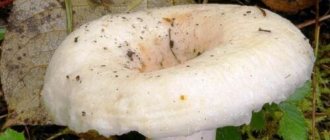Photo Champignons from Woodmen19 (Yandex.Photos)
Champignons - this mushroom is not a curiosity; it can be grown well in large quantities in special greenhouses; there are even different varieties of Champignon , differing in taste, fertility and cap color: brown, cream and white.
But Champignon also has wild counterparts that grow in the wild and have a much brighter taste and aroma: wild Champignon grows in open clearings, meadows, and can often be found in pastures where cows graze and the soil is richly fertilized with manure. Slightly less commonly, Champignon can be found in sparsely planted mixed forests, where the sun's rays can reach the forest floor.
What does Champignon look like?
A characteristic feature of the Champignon is the pink bottom of the cap (plate), covered with a thin white skirt. As the mushroom grows and matures, the cap opens and the pink color of the plates begins to darken. in old champignons it becomes charcoal black, and in very young ones it turns pale pink - using this sign you can accurately choose mushrooms in the store.
Where do they grow?
Champignons grow in places where the soil is well fertilized with humus or manure. They begin to appear soon after the rains. They grow in small families on compost-fed soils of vegetable gardens and orchards, in clearings, fields and meadows, and near roads. These mushrooms love to grow in places where cows graze. They also love swamps. The Sverdlovsk region is very popular among mushroom pickers. Sverdlovsk forests with their wetlands seem to have been created by nature for the growth of mushrooms. People come here specifically to pick up baskets full of mushrooms. Champignons are also found in urban areas, growing along sidewalks and highways.
How to distinguish Champignons?
Young wild Champignons must be distinguished from Pale Toadstool (a very poisonous mushroom). How to distinguish Champignon from Pale Toadstool ?
1. The color of the plates differs: in champignons - from pink in young ones to brown in old ones, in the pale toadstool - always white.
2. The base of the leg of the Pale Toadstool is framed with a film, like a fence.
When to collect?
Champignons appear early in the southern regions, where the sun warms up well in early spring. In such regions, you can go on a “silent hunt” already at the end of April, beginning of May. Another condition for the early growth of mushrooms is high humidity. In the northern regions, the first growth can be observed only in the summer, in July or early August, when the second peak of fruiting occurs.
Field representatives can be found from May, and they are collected until October. Forest species appear in July and grow until mid-autumn. The largest harvests are observed in August and September. Meadow mushrooms appear in mid-May. Their collection can also continue until October.
Where do mushrooms grow in nature?
Champignons are taking root everywhere. Almost any area is suitable for the growth of these mushrooms. These are clearings, forest edges, lowlands, mountain forests, roadside ravines and many other places. They can be found in the garden, vegetable garden and meadows. Even semi-deserts and deserts become a good refuge.
Expert opinion
Gennady Sergeevich Rylov
A great expert in mycology and an avid mushroom picker. Knows everything about mushrooms, their types and places of growth
These mushrooms choose places rich in organic matter. They can be found on manure heaps, compost pits and landfills. Where people keep livestock, champignons usually appear. In isolated cases, mushrooms grow directly on a forest road, breaking through a dense layer of soil.
It loves soils with a high content of humus, the bark of dead trees, and anthills. Champignons can be classified according to the substrate on which they grow. There are species that grow only in forests. Other representatives settle in open areas. Some species are found in grass or wastelands.
It is not difficult to find mushrooms. They often hide under a loose soil layer. Usually this is a tubercle with a gap above it. When a layer is ruptured, a whole family can be discovered. Mushrooms are most widespread in the forests and forest-steppes of Europe and Asia.
How they grow
The total fruiting period is from 8 to 14 weeks. During this period, the mushroom produces 7-8 crop shoots. The intervals between waves do not exceed 6-7 days. Active growth of mycelium begins after moisture enters the soil. After a few hours, the stem and cap are already growing.
Full ripening to maturity occurs in 8-10 days. With specialized cultivation, up to 15 kg of mushrooms are collected from one square meter in 2-3 months.
What can you cook?
Toxic representatives are rarely found in our regions. Edible fruiting bodies are found everywhere. Productivity depends on the warmth of the region. Dispora are grown on an industrial scale on special farms.
Some types of champignons are consumed raw. They are classified as fast food products. Because no need to pre-boil. It is enough to clean, rinse well and immediately prepare the main dish. Champignons are good fried or baked. They are used to make soups and include them in grilled dishes.
Juliennes and omelets and vegetable stews are very tasty. They can also be canned, but the shelf life when pickled is not as long as that of other mushrooms.
They grow everywhere; it is prohibited to collect them in landfills and along highways. They quickly absorb toxic waste. Ordinary champignons collected in a contaminated area can cause poisoning. The taste is best in young fungi, when the cap is still convex and the plates are pale pink.
There is a simple way to distinguish an inedible species from a good champignon. To do this, you need to break the pulp. In toxic species it always turns yellow. Most edible representatives acquire a pinkish color if the flesh is damaged.
Growing champignons in the country or at home: step-by-step instructions
Due to its taste, champignon is a welcome guest in the human diet, so growing champignons at home, in the country or in the basement has become widespread. There are not many conditions and methods for growing champignons. These mushrooms love moisture and coolness, so they can be grown both in open ground and in greenhouses or greenhouses. However, it is most profitable to grow champignons in darkened and humid basements, where special climatic conditions have been created that allow harvesting all year round.
Substrate for growing champignons
A nutrient substrate consisting of straw and manure is used as soil. After several harvests, the waste material can be used as fertilizer for agricultural areas. By the way, preparing the substrate is the most important and difficult stage in the technology of growing champignons. After all, the result depends on the nutrient medium.
A substrate is a soil mixture containing nutrients, the main component of which is compost.
To prepare compost for growing champignons, you will need:
- 20-25% fresh, well-dried straw without signs of mold (preferably wheat or obtained from winter rye)
- 75-80% horse (ideally) or cow manure.
Compost for growing champignons: preparation stages
- For 1 sq. m. area, which is allocated for a mushroom plantation, requires 30 kg of pre-moistened straw and 15 kg of manure.
- Each component is laid in several layers (3-4 layers) and a substrate is formed. The straw is moistened and fertilized with a manure “layer”.
- After a week, 6-7 kg of gypsum (or alabaster) is added to the substrate, and all layers are thoroughly mixed.
- Re-mixing must be done after 4 days and, if necessary, re-wet the mixture. Then 2 kg of superphosphate and 5 kg of crushed chalk are added. With a time interval of 4 days, two more mixings of the components occur.
- After 3-4 weeks from the moment of formation, the compost for growing champignons is considered ready.
Technology of growing champignons
For sowing, laboratory mycelium of champignons is required. There are two types of mycelium: grain and compost. You can buy champignon mycelium at any specialty store or at specialized mushroom farms.
Methods for sowing mycelium depend on the location chosen for planting champignons. The sowing process itself is not at all complicated. The mycelium is deepened into the substrate by 4-7 cm in a checkerboard pattern. There should be gaps of about 20 cm between the sowing areas.
It is very important to maintain an optimal level of humidity in the room during the ripening period. After about a week, the soil must be covered with a covering mixture made from chalk and peat (1:9).
After 5 days, the temperature in the room should be lowered to 13-17°C.
Regular watering of the soil is definitely required, and the room needs daily ventilation.
How to harvest champignons?
Champignons ripen unevenly over a period of 3 months. You need to collect them by carefully twisting them with your fingers so as not to damage the “relatives” growing nearby. When the entire champignon crop has been harvested, it is important to thoroughly treat the room with a disinfectant.
Dangerous species
The champignon family also has poisonous relatives, which you need to learn to distinguish.
Yellow-skinned
One of the well-known poisonous mushrooms, which is often confused with field or common champignon. The yellow-skinned champignon has a rounded cap and a high stem. The edges of the cap gradually straighten and open. Those who have never encountered yellow-skinned champignon need to know that the skin of this mushroom is actually white, but when damaged or cut, the stem acquires a characteristic yellow color.
Preparation and processing
Before cooking champignons, you should remove all worm-eaten areas and clear the mushroom of debris. The champignon legs need to be cut off almost completely, leaving only 1.5 cm of the total length. The skin of mushrooms is often removed from the cap. Then they are washed in cold water.
Forest champignons are used as a side dish for meat; they can be stewed, fried, or boiled. They are also suitable for drying. Champignons are often frozen; in this form they are edible for a year. These mushrooms can also be eaten raw.
The sauce for cereals made from champignons with herbs is also good. Often these champignons are stuffed with meat and cheese and made into cream soup. There are also recipes for mushroom caviar made from champignons on the Internet.
Growing mushrooms yourself
In the modern world, champignons can be bought in any store, in any market. But many summer residents and gardeners dream of growing these mushrooms themselves. But for this you need to have certain knowledge, first of all about planting material (mycelium). Growing mushrooms can turn into not only an exciting hobby, but also a good business . There are several methods of growing technology:
On open ground. For growing this type of mushroom, a moist area with a lot of shade is well suited. First you need to fertilize the soil with rotted manure. And then directly plant the substrate with mycelium. This should be done in spring or autumn, preferably on a rainy day. The holes should be 5-6 cm deep, and the distance between them should be 30 cm.- In enclosed spaces. They should maintain a constant temperature of 10−15 °C. Sudden changes inhibit the development and growth of fungi. Avoid exposure to direct sunlight. In such cases, the substrate for mushrooms is purchased ready-made, and the myceliums are arranged in ordinary boxes.
- Growing on compost. This is the best method. For compost you need to use horse manure with straw. Lay it in layers in a ratio of 1:2 or 1:1. The resulting bed should be well watered and covered until the temperature inside the stack rises to 55 °C. Then you should re-break the stack and cover it again. Such actions must be performed until the compost becomes a loose brown mass. Next, boxes are filled with ready-made compost to a height of 25–30 cm. When its temperature drops to approximately 20 °C, mycelium can be planted. Within two to three weeks, the mycelium will germinate and filaments of mycelium will appear on the surface. The main thing is not to miss this moment, since at this stage the compost should be covered with a layer of a mixture of peat and chalk (in a ratio of 2:1).
- Simplified method. This method is for the laziest. You need to purchase a bag of ready-made compost, which already contains the mycelium itself. But in this case, you need to pay attention to the packaging date, since the longer this bag is stored, the less likely it is to get a good harvest. Ready compost with mycelium has a shelf life of approximately 10-14 days.
How to distinguish a real champignon mushroom from a false one
Forming mushroom blocks
Champignon blocks are compost wrapped in shrink film. The substrate is taken pressed. This one is available for sale
It’s easier to buy, but it’s important to choose a reputable supplier, because compost can be contaminated. It is difficult to infect ready-made blocks, because polyethylene is impenetrable to pathogenic organisms
The convenience of growing champignon mycelium in blocks is that they are compact, easy to transport, and stack on shelves or in pallets.
There is almost no dirt from compost wrapped in film; it is convenient to remove it from the premises when moving or closing a business. By the way, the yield on blocks is 20-50% of their weight. It, in turn, ranges from 2.5 to 20 kilograms.
Mushrooms cannot grow through polyethylene. Therefore, slots are made in the upper plane of the blocks laid on the beds or shelves. Moisture comes out of the substrate through them. Burlap will help avoid this. Blocks cover it from above.
At the stage of mycelium germination, champignons almost do not need light, so in this regard, the tissue will not interfere with the development of mushrooms. In the usual sense, it is a product consumed as food.
By the way, champignons can even be eaten raw. But, in the scientific community, the mushroom is an underground body, and on top is the fruit. The lower part is correctly called mycelium. It is placed into blocks through the same slots.
Spores are taken from the fruit. Reproduction by pieces of maternal mycelium is possible. The grain mycelium produces an abundant harvest. It is sold online. About 400 grams are needed per square meter of substrate.
Recipes
Mushrooms of the Primorsky region (edible and poisonous): names, photos, description.
where do they grow and when to collect? Below are several simple recipes for frying porcini mushrooms using additional ingredients.
With sour cream
Fried porcini mushrooms with sour cream
- Boletus mushrooms – 500 gr.
- Onions – 2 pcs.
- Sour cream – 1 tbsp. spoon.
- Vegetable oil – 4 tbsp. spoons.
- Flour – 1 teaspoon.
Cooking:
- Fry the onion in a frying pan in oil until golden brown.
- Add chopped mushrooms to the onion.
- When the fruit bodies are browned, add a teaspoon of flour and a tablespoon of sour cream, and then fry until tender.
Mushrooms can be served with potatoes or stewed vegetables, supplemented with garlic, parsley and any other herbs.
With tomatoes and eggplants
Fried porcini mushrooms with tomatoes and eggplants
- Boletus mushrooms – 6 pcs., medium size.
- Eggplant – 1 pc.
- Cherry tomatoes – 10 pcs.
- Onions – 1 pc.
- Tomato paste – 1 tbsp. spoon.
- Garlic – 2 cloves.
- Basil – 1 tbsp. spoon.
- Vegetable oil – 3 tbsp. spoons.
- Salt and pepper - to taste.
Cooking:
- Cut the onion into half rings and the carrots into small cubes.
- Fry the onion in a frying pan in oil until golden brown, then add carrots to it and fry everything together for 4 minutes.
- Place the mushrooms and chopped eggplants into the pan and mix thoroughly. When they are slightly browned, pour a little water into the pan, add a tablespoon of tomato paste, a little sugar to neutralize its sourness, as well as pepper and salt. Simmer everything for 5 minutes, stirring occasionally.
- Add cherry tomatoes and garlic to the pan, stir everything thoroughly and simmer for another 4 minutes.
- Sprinkle the dish with herbs of your choice and leave the dish to sit on the stove for 10 minutes.
With chicken fillet
Fried porcini mushrooms with chicken
- Boletus mushrooms – 6 pcs. medium size.
- Chicken fillet – 100 gr.
- Cream – 200 ml.
- Flour – 0.5 teaspoon.
- Onions – 1 pc.
- Salt and pepper - to taste.
Cooking:
- Fry the onion in a frying pan in oil until golden brown.
- Add chicken fillet, cut into small pieces, into the pan and fry for 5 minutes.
- Place the chopped mushrooms in the pan and fry, stirring gradually, for 15 minutes.
- Pour in the cream, add flour, mix everything thoroughly and simmer for another 10 minutes.
The finished dish can be served with pasta or fried potatoes.
With bell pepper
Fried porcini mushrooms with bell pepper
- Boletus mushrooms – 400 gr.
- Sweet bell pepper – 3 pcs., large.
- Onions – 1 pc. medium size.
- Olive oil – 3 tbsp. spoons.
- Salt and pepper - to taste.
Cooking:
- Cut the pepper into strips and the onion into half rings.
- Cut the boletus into slices, place in a hot dry frying pan and fry a little in it, then add oil, add onions and peppers, and fry until tender, stirring regularly. At the end of frying, add pepper and salt.
With cream and cheese in pots
Fried porcini mushrooms with cream
- Boletus mushrooms – 1 kg.
- Fresh cream – 500 ml.
- Butter – 100 gr.
- Green beans – 400 gr.
- Cheese – 200 gr., hard varieties.
- Onions – 3 pcs., medium size.
- Italian herbs – 1 tbsp. spoon.
- Salt and pepper - to taste.
Cooking:
- Fry the onion in a frying pan in oil until golden brown, then add the mushrooms and fry for 15 minutes. Add salt at the end of the roasting process.
- Grease baking pots with oil and place beans on the bottom. Place the boletus with vegetables in a pot and sprinkle with grated cheese.
- Add Italian herbs and salt to the cream, mix everything thoroughly and pour into the pots. Add grated cheese and pieces of butter again.
- Close the pots and bake for 30 minutes in the oven at 190 degrees.

